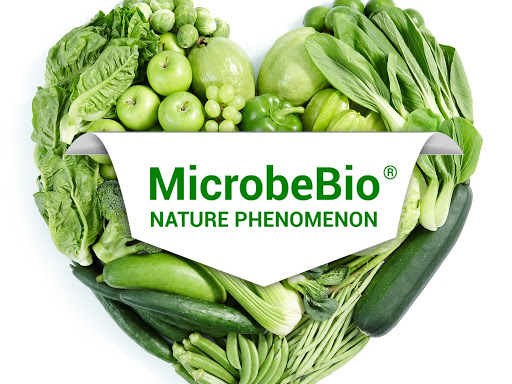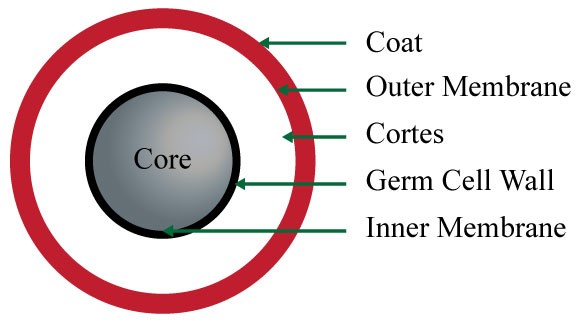BENEFICIAL MICROBES IN MICROBEBIO®
Our microbial products contain an unparalleled proprietary formula of 50+ strains of microorganisms. The most notable difference between our line of microbial products and that of other manufacturers is encompassed in the following three words: Bio-diversity, Endospores, and Equilibrium.
We have conducted rigorous lab and field compatibility studies in Africa, southeast Asia, and the U.S. to ensure the synergy and efficacy of this formula:
- Bio-Diversity: This chain of 50+ strains of bio-diverse microorganisms are critical for promoting nutrient cycling in soil when applied to the root zone or as a foliar treatment.
- By contrast, mono-cultural strains (without diversity) are susceptible to environmental pathogens and more easily succumb to lysing, denaturation of their DNA, and death
- The bio-active potential of these microbial spores (vs. “live” microbes which live and die), ensure a longer duration of nutrient uptake by plants throughout all phases of the growth cycle
- Endospores: Our products contain viable bacteria, sporulated via fermentation.
- Rationale: Spores (vs. active cells) limit metabolism and catabolism, thereby increasing shelf life and minimizing excessive genetic mutation of bacterial cells, which can lead to mutant cells that do not perform the way they were intended.
- Converting our products into endospores ensures fidelity (long-term activity), significantly reduces genetic mutations and stabilizes the quality of the product.
- By contrast, the quality of viable (“live”/active) cells in a container risk jug expansion or compression due to excess metabolism or CO2 production in the container.
- Endospores are absolutely the preferred form due to their preservation, fidelity, quality assurance of performance in the field, and high shelf life.
-
- Equilibrium: After many QA trials, we believe that a heterogeneity of microbes promotes a prolonged duration of soil balance, resulting in season-long composting by the bacteria.
- Biodiversity and redundancy allows for
- Accelerated organic mineralization in the soil
- Nutrient release
- Perimeter protection against pathogens
- Improved soil tilth leading to better air and water channeling
- Biodiversity and redundancy allows for
Here is a partial list of our proprietary formula of microbial spores and their functions
BENEFICIAL MICROBES
Genus Azotobacter
- Aids nitrogen fixation in association with non-leguminous plant roots in the presence of oxygen (which usually inhibits the nitrogen fixing enzymes). By contrast, others do so by consuming all oxygen sources within their immediate surroundings.
- Increases uptake of N3‑ (atmospheric nitrogen). Historically, microbes were discovered as the original mediator for N3‑ Produces three enzymes, catalase, peroxidase and superoxide dismutases to neutralize reactive oxygen species.
Genus Bacillus
- Nutrient Decomposition: Assists resistance to environmental factors such as heat, desiccation, radiation and chemical attacks which can persist in the environment for long periods of time. The endospore is activated at times of nutritional stress, allowing the organism to persist in the environment until conditions become favorable.
- Enzyme, Plant-Growth Hormones, Soil Structure: Produces enzymes, antibiotics, and small metabolites. It produces a variety of extracellular enzymes that are associated with the cycling of nutrients in nature.
- C:N Ratio (Carbon & Nitrogen): Isolates the nitrate reductase enzyme to increase beneficial anaerobic respiration on nitrate. Additionally, oxidizes carbon monoxide aerobically.
- Phosphate Solubilization: These microorganisms join together by polysaccharides on the cell wall to extract inorganic phosphorus from insoluble compounds. Used as a preventative measure to inoculate plants against pathogens. Also used in the making of penicillin and enzymes.
- Lactic Acid Formation: Amends soil with organic materials for rapid microbial growth to significantly increase nutrient uptake.
- Prophylactic: Boosts bacterium growth which prevents rhizoctonia and fusarium spores from germinating. Builds high resistance to environmental stresses including UV light exposure, desiccation and the presence of oxidizers.
- Bio-pesticide: Functions as a natural insecticide and endotoxin in many insecticides and pesticides.
Genus Paenibacillus
- Nitrogen Fixation (conversion), nutrient cycling, soil structure: Capable of fixing (converting) nitrogen into a compound that is readily accessible by plants. The sources of less-accessible nitrogen (N2) are found in soil, plant roots, marine sediments, and the atmosphere.
- Prevents Pathogen Encroachment: Similar to other strains, these bacteria form bio-films on plant roots to produce exopolysaccharides (probiotics) which suppress pathogen proliferation (fights plant diseases) and induce systemic plant resistance.
Genus Pseudomonas
- Pathogen Reduction: Produces antimicrobial compound PCA-phenazine-1-carboxylic acid (C13H8N2O2) which prevents Rhizoctonia and Fusarium spores from germinating when applied to seedlings
- Auto-Immune Disease Reduction: Via Aerobic Denitrification and Nitric oxide dis-mutation
Genus Streptomyces
- Significant Anti-biotic: Commonly found in soil and deep sea sediments. Demonstrates significant activity against organisms that cause plagues and diseases by producing antibiotics
- Anti-fungal: Strong in-vitro antagonism against various fungal plant pathogens in plate assays by producing extracellular anti-fungal metabolites
Genus Trichoderma
- Strong preventative nematicidal (anti-worm) measure: Applied to root zone as an anti-fungal Penicillium which treats Botrylis and Fusarium.
MYCORRHIZAE:
Genus Glomus
- Supports root extensions
Genus Saccharomyces
- A species of yeast involved in secretory pathways of antibodies against diseases
- Equilibrium: After many QA trials, we believe that a heterogeneity of microbes promotes a prolonged duration of soil balance, resulting in season-long composting by the bacteria.

